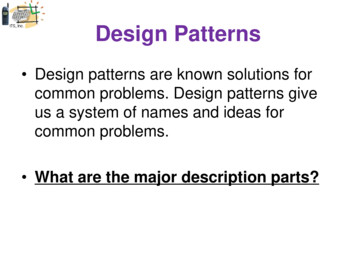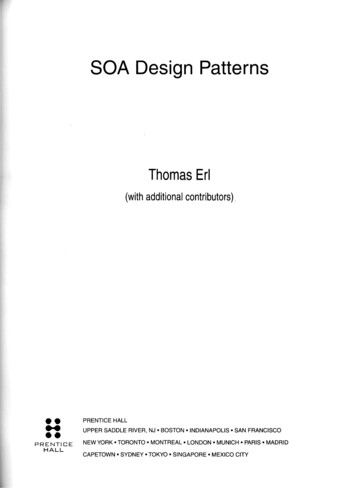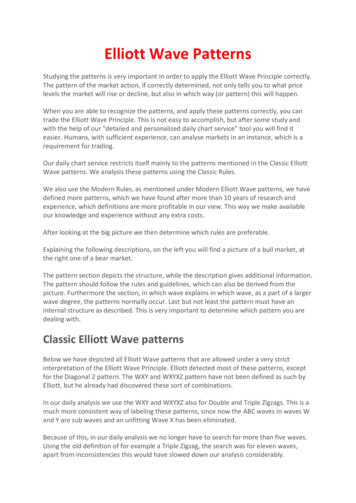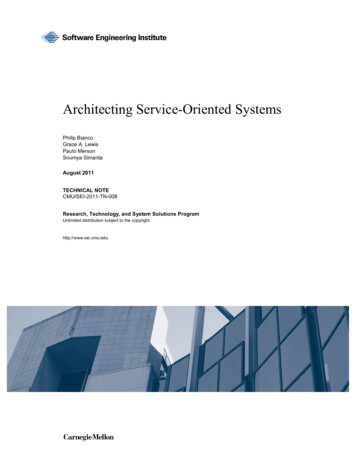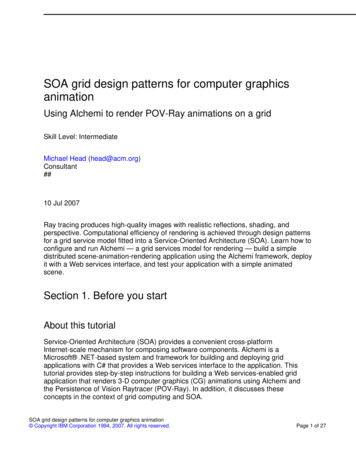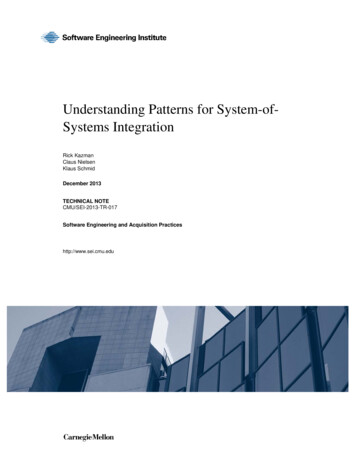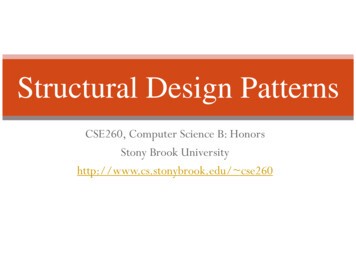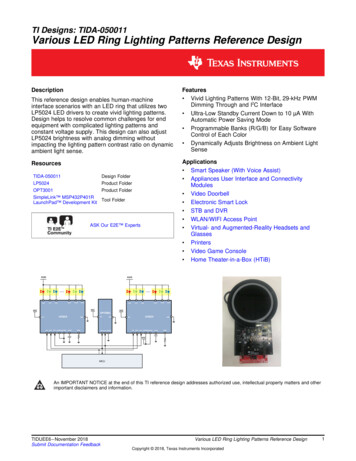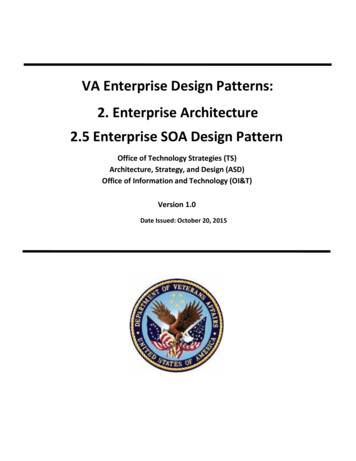
Transcription
VA Enterprise Design Patterns:2. Enterprise Architecture2.5 Enterprise SOA Design PatternOffice of Technology Strategies (TS)Architecture, Strategy, and Design (ASD)Office of Information and Technology (OI&T)Version 1.0Date Issued: October 20, 2015
THIS PAGE INTENTIONALLY LEFT BLANK FOR PRINTING PURPOSES
APPROVAL COORDINATIONTIMOTHY LMCGRAIL111224Otg1i.llyby TIMOTHV LMCGRAIL11122 4dc gov,ON:OUde '-' ·o Internal,peep.:.' !.!!:. - rDate:11122-40.lr. 2015.10.20 14;12;14 " 4'00'Tim McGrailSenior Program AnalystASD Technology StrategiesPaul A .Tibbits,M.D.DCIO Architecture,Strategy,and Design
REVISION HISTORYVersionDateOrganization0.14/30/15ASD TS0.36/1/15ASD TS0.56/19/15ASD TS0.78/10/15ASD TSNotesInitial DraftUpdated draft to include additional researchfrom working sessions (e.g., benefits andmemorials use cases), and to adjudicatefeedback from stakeholders. Also removedcontent from previous VistA Evolution DesignPattern and aligned content with ESS strategyand SOA design guidance.Updated draft for 6/16 working session toinclude research on ESS use cases and toadjudicate feedback from previous workingsessions (6/2 and 6/10) and ESS Architectureworking group (6/8).Additional edits taking into account feedbackfrom Public Forum.REVISION HISTORY 158/10/15ApproverJoseph BrooksJoseph BrooksJoseph BrooksJoseph BrooksRoleASD TS Design Pattern Government LeadASD TS Design Pattern Government LeadASD TS Design Pattern Government LeadASD TS Design Pattern Government Lead
TABLE OF CONTENTS1.0 INTRODUCTION. 11.1 BUSINESS NEED . 11.2 APPROACH . 12.0 CURRENT CAPABILITIES AND LIMITATIONS . 22.1 CURRENT CAPABILITIES . 22.2 LIMITATIONS . 33.0 FUTURE CAPABILITIES . 33.1 ALIGNMENT TO TRM . 64.0 USE CASES . 74.1 HEALTHCARE ESS INTERACTION . 74.2 BENEFITS, MEMORIALS, AND CORPORATE ESS INTERACTION . 9APPENDIX A.DOCUMENT SCOPE . 12SCOPE . 12DOCUMENT DEVELOPMENT AND MAINTENANCE . 12APPENDIX B.DEFINITIONS . 13APPENDIX C.ACRONYMS . 14APPENDIX D.REFERENCES, STANDARDS, AND POLICIES . 15APPENDIX E.ENTERPRISE SHARED SERVICES (ESS) . 17FIGURESFigure 1: Layered SOA Capabilities Framework for ESS . 5Figure 2: High-level Context Diagram for Healthcare ESS Interaction . 9Figure 3: High-level Context Diagram for Benefits ESS Interaction . 11TABLESTable 1: Enterprise SOA Categories and Approved Technologies . 6Page i
1.0 INTRODUCTIONService-oriented Architecture (SOA) is an architectural approach to simplify enterprise IT bystandardizing how systems communicate and by breaking larger, monolithic systems into a setof reusable business services. SOA provides a uniform means to offer, discover, interact with,and use capabilities to produce desired effects consistent with measurable preconditions andexpectations. VA plans to deploy Enterprise Shared Services (ESS) that enable all applications toconsume SOA-based resources across VA and external partners consistently.1.1 Business NeedSubstantial VA IT investments have focused on consolidating IT infrastructure and exposinglegacy resources as reusable SOA services to enhance interoperability, improve security, andreduce operational costs. This document establishes an official enterprise direction for VA’smigration to a SOA environment using ESS and common IT infrastructure platforms. ESS willhelp VA achieve the following goals: Advance organizational interoperability and agility through the reuse, interoperability,and governance of services across internal and external organizational and programboundaries.Promote the standardization, reuse, interoperability, and composition of the bestavailable capabilities developed under the auspices of any system to meet business andmission requirements.Projects deploying solutions that use ESS will help VA resolve recurring challenges to improvingand evolving information security, advancing agile interoperability and information sharing, andreducing the total lifecycle cost of IT per the VA Enterprise Technology Strategic Plan (ETSP) andthe Enterprise Design Patterns Directive (VA Directive 6551).1.2 ApproachThe Enterprise SOA Design Pattern aligns with VA’s overall IT strategy for supporting “anydevice, anywhere, anytime” for VA patients, customers, staff and partners through enterpriseservices. This document provides an overarching guideline for the ESS Strategy and Roadmapmaintained by ASD Product Engineering, and it supports an enterprise-wide directive for ESSintegration. The ESS roadmap involves achieving enterprise-wide agreement on architectureand governance approaches, and identifying candidate ESS that align to strategic businesscapabilities characterized in the VA EA and in ASD Product Planning Documents (PPD). Thisroadmap also includes plans for SOA infrastructure services over the next three fiscal years toPage 1
support expanded ESS provisioning, management, and consumption. A summary of theapproach for adopting ESS in VA for interoperable data sharing is as follows: Phase 1: Establish Governance:o Establish the ESS Center of Excellence (CoE).o Gain agreement on governance approaches for ESS across all lines of business.Phase 2: Establish Standards:o Establish project-level service design guidelines for ESS architecture,development, and support.o Publish ESS implementation guidance and disseminate to project teams.Phase 3: ESS Execution:o Deploy SOA infrastructure capabilities to support current and projected ESS.o Architect, deploy, and sustain ESS in accordance with VA business needs intakeand analysis, and PPDs.o Support migration of legacy systems to ESS available through VA’s SOAinfrastructure.Phase 4: Continual Improvement:o Update governance processes, standards, and service design guidelines toaccount for lessons learned.o Evaluate the current and future state of SOA infrastructure and develop aroadmap for evolving the SOA infrastructure to accommodate emergingtechnologies.This approach establishes a framework for mandated ESS following the latest industrystandards. Appendix E contains the current list of mandated ESS supporting high-level use casesdocumented in Section 4. Platform-specific implementation guidance for ESS is beyond scope(see Appendix A), but is available by ASD Product Engineering.2.0 CURRENT CAPABILITIES AND LIMITATIONS2.1 Current CapabilitiesVA agreed to the SOA environment for all healthcare applications that shared data with VistA inNovember 2013. Since then, the product lines that constitute VistA Evolution adopted severalSOA services to use modern web services instead of point-to-point connections to legacybusiness logic (per the VistA Evolution Product Roadmap). This migration includes theEnterprise Messaging Infrastructure (eMI), which is the official SOA infrastructure backbonecapability for ESS. VA has established an ESS CoE to serve as an advisory body for adopting ESSacross lines of business going beyond healthcare. This organization is establishing governanceprocesses and service design guidelines available on the ESS website. Governance processesand service design guidelines constitute an “implementation” of the SOA to which VA ismigrating.Page 2
The ESS CoE has crafted an ESS strategy, which provides a long-term guideline for identifyingand provisioning the ESS required to develop solutions useful to the enterprise. As such, part ofidentifying ESS is to consider how a service contributes to solutions, either as business servicesproviding business solutions or as infrastructure services from which business services arecomposed. Using ESS in accordance with this Enterprise SOA Design Pattern will help projectsmeet the criteria for Enterprise Capabilities in Section 2.6 of the VA ETA Compliance Criteria:“VA solutions shall utilize enterprise-wide standards, services, and approaches to deliverseamless capabilities to Veterans, facilitate IT consolidations through reuse, and simplify theuse of Veteran functions.”2.2 LimitationsVA’s adoption of ESS to achieve an enterprise SOA is still a work in progress. The ESS CoE willcontinue to work with stakeholders across VA to achieve a shared vision for ESS and a migrationto an enterprise SOA environment. “Local” SOA is still prevalent in many parts of VA (e.g.,Veterans Benefits Management System), and the ESS CoE will provide the official SOAgovernance structure and advisory board to standardize SOA capability implementation. Thecurrent SOA infrastructure for ESS was based on a decision to reuse existing IT investmentsfrom the Integrated Electronic Health Record initiative, and future activities will look at theevolution of this infrastructure to accommodate emerging technologies captured in the ETSP.3.1 FUTURE CAPABILITIESThe future state for enterprise SOA consists of the following aspects addressing the approach inSection 1.2, which include continual improvement to account for lessons learned and changingbusiness needs: A standard set of governance processes for ESS across all lines of business (Phase 1)Completed service design guidelines for ESS architecture, development, and support(Phase 2)Fully operational SOA infrastructure capabilities to support current and projected ESS,with a roadmap for SOA infrastructure evolution (Phase 3)Registry of ESS in accordance with VA business needs intake and analysis, and alignmentof business needs to strategic goals (Phase 3)Page 3
The ESS website and the eMI reference in Appendix D contain information on how to integratewith the eMI. The supporting Enterprise Design Patterns provide additional details onenterprise capabilities and constraints for middleware platforms like eMI.ESS require adherence to the following SOA design principles agreed to by the ESS CoE: Encapsulation: Advocates exposing a discreet system capability as an autonomous ITasset (that is, a service) that can be used by any application that requires the capability Separation of Concerns: Advocates separating different aspect of software system sothat each aspect can be developed independently and maintained autonomously Loose Coupling: Advocates reducing dependencies between system components andmaking all remaining dependencies explicit Business Traceability: Advocates using well-defined heuristics to maintain the “line ofsight” from business requirements to the system capabilities that support themAll VA application solutions use a layered architectural framework consistent with the abovedesign principles. This means that applications will not access physical data stores directly, butwill use abstracted information services that encapsulate the data stores and enable virtualdata access. ESS aligns to specific service types and layers in the following figure depicting aplatform-independent architecture framework:Page 4
Figure 1: Layered SOA Capabilities Framework for ESSThe Open Group’s SOA Reference Architecture1 guides the categorization of ESS and is used toinform ESS architecture guidance and governance processes for Phases 1 and 2. The ESS CoEwill use the following categories to describe service functionality:1 Interaction: Client-centric services (e.g., portal services) tied to organizational roles andsolution applications. Process: Business processes services (e.g., workflows) are tied to an organization’s wayof doing business. Business Application: Stand-alone services that provide a discreet, business-relatedcapability specific to a narrow set of service domains. Likely has a single business owner. Information: Services (e.g., data access services, data federation services) that provideinformation related to business entities; broadly used across processes and less specificthan process services.The Open Group, SOA Reference Architecture, ISBN: 1-937218-01-0, November 2011Page 5
Utility: Stand-alone services that provide a discreet, business-related capability usedacross a wide range of service domains; normally has broad cross-section ofstakeholders. Access: Services (e.g., adapters) that provide access to legacy systems and whoseservice interfaces are tightly coupled to the legacy system interface. Partner: Services capturing interoperability with partners, isolating VA from changes.The Service Layering and Service Categorization Guideline (published on the ESS website)provides detailed implementation guidance on each abstraction layer and service category thatinforms solution architecture development. Future versions of this document will include linksto these guidelines and additional details on the architecture modeling activities.3.1 Alignment to TRMAll projects require approved technologies and standards located in the VA Technical ReferenceModel (TRM) to comply with the guidance provided in this document. The following technologycategories specific to the use cases described in Section 4 include:Table 1: Enterprise SOA Categories and Approved TechnologiesTool CategoryExample Approved StandardsIntegration SoftwareEnterprise Service Bus, Service Registry, Messaging-Oriented Middleware, SOAGovernance, Device IntegrationData IntegrationData at Rest, Data in Motion (Common Message Terminology and Semantics),Database Replication and Clustering (e.g., Extract, Transform, Load)The Enterprise SOA Design Pattern serves as a gateway to other Enterprise Design Patterns thatrefer to applicable ESS, as discussed in Appendix E. Each Enterprise Design Pattern contains areference to applicable TRM categories. This information will help projects guide theirtechnology selection and plan for future technologies. All projects leveraging enterprise SOAcapabilities to achieve interoperability objectives will: Adhere to the profile of information exchange standards (REST for new serviceinterfaces and SOAP for legacy interfaces) outlined in the ESS Message Exchange Guide(posted on ESS website).Use only approved standards profiles documented in the TRM. Standards not includedin the TRM require a waiver that is approved only by the Deputy CIO of ASD.Page 6
For healthcare information exchange, comply with the standards profile enforced by theInteragency Program Office (IPO) and described in the IPO Information InteroperabilityTechnical Package (IT2P) and DoD/VA Health Standards Profile (HSP).4.1 USE CASESThe following sections describe a generic use case involving an application consuming ESSthrough an enterprise-wide SOA infrastructure. This analysis includes references to EnterpriseDesign Patterns posted on the ASD TS public-facing website (Reference 2 in Appendix D). Eachuse case contains the following attributes agreed to by the ESS CoE: Pre-Conditionso Define starting point for service useInputso Configure the interaction with the serviceBehaviorso For satisfied preconditions, use inputs and leads to specified outputs and postconditionsOutputso Deliver immediate feedbackPost Conditionso Define the end state when service interaction is complete4.1 Healthcare ESS InteractionThe following use case refers to a generic service interaction involving Department of Defense(DoD), VA, or other external partner (e.g., Walgreens) consumers with the goal of retrievinghealthcare information (e.g., official patient records, prescription information, patientgenerated data), subject to appropriate security and privacy restrictions.1. Pre-Conditionso Requestor authenticated to an application through security services platform(currently provided by IAM services).o Example VA applications (portals, web applications, mobile applications, kiosks) Enterprise Health Management Platform (eHMP) Clinical PresentationExperience (CPE) application Veterans Point of Service (VPS) application Mobile Patient-generated Data (PGD) (Data Access Services) application External non-VA client (e.g., DoD healthcare application)2. Inputso VA user invokes a service request to access VA healthcare informationPage 7
This may occur through a mobile application in accordance with theMobile Architecture Design Pattern. Appendix D Reference 2 includesthe public-facing website that contains this Enterprise Design Pattern.IAM services authenticate the service consumer and support accesscontrol decisions per the Privacy and Security Design Patterns.3. Behaviorso External service consumers use an External Gateway ( a k a S O A G a t e w a yS e r v i c e ) capability to access services. The External Gateway refers to the eHealth Exchange for commercialconsumers like Walgreens. DoD consumers leverage services as outlined in the VistA EvolutionInteroperability Plan. Currently, DoD consumers may also use the eHealthExchange if they do not use the Bi-directional Health InformationExchange (BHIE) DoD Adaptor (per the eHMP architecture). In the longterm, the Defense Health Management Systems Modernization(DHMSM) data services will continue to leverage these services.o Request goes to service provider. The Enterprise Messaging Infrastructure (eMI) provides integrationmiddleware for a service provider that is part of the VistA Evolutionprogram. Invalid service requests will produce error messages to user throughexception handling, and failed attempts are to be logged in accordancewith Privacy and Security Design Patterns.o Service providers exposed through service proxies and service entries. Service interfaces are to be defined in accordance with the ESS MessageExchange Guide. Enterprise service registry needed to document the services.o Service provider processes request through a “wrapper” data access service (perthe Hybrid Data Access Design Pattern) and prepares response in accordancewith requestor’s expectations.o Response from VistA instances generated through data federation platforms(currently VistA Service Assembler).4. Outputso Response routed back to requestor.5. Post Conditionso Requestor obtains application response based on initial expectations.o A data warehouse capability (e.g., the Corporate Data Warehouse) collects datafrom authoritative data stores for business intelligence and analytics purposes.VistA will continue to provide batch feeds to the data warehouses, as indicatedby the solid arrow.The following figure provides an architectural blueprint for the use case:Page 8
Figure 2: High-level Context Diagram for Healthcare ESS Interaction4.2 Benefits, Memorials, and Corporate ESS InteractionThe following use case refers to a generic interaction between an internal or external serviceconsumer and a VA application, allowing the consumer to retrieve benefits information(including memorials information).1. Pre-Conditionso Requestor authenticated to an application through security services platformand authorized to access information. Currently these are provided by IAMservices. Please consult Privacy and Security Design Patterns for detailedarchitectural guidance on these capabilities.Page 9
oExample VA applications (portals, web applications, mobile applications, kiosks) Enterprise Veterans Self-Service (eBenefits) National Gravesite Locator (NGL) application MyHealtheVet (MHV) VRM Customer Relationship Management (CRM) client2. Inputso VA user sends in a service request to access VA healthcare information This may occur through a mobile application in accordance with theMobile Architecture Design Pattern, leveraging a user interactioncapability per the User Interaction Capabilities Design Pattern. IAM services authenticate the service consumer and support accesscontrol decisions per the Privacy and Security Design Patterns.3. Behaviorso External service consumers use an External Gateway capability to accessenterprise services. The External Gateway in this context may refer to a web server proxylocated in a perimeter network.o Service request goes to service provider. Invalid service requests will produce error messages to users throughexception handling, and failed attempts are logged in accordance withthe Privacy and Security Design Pattern. Service request may either be brokered or go directly to the serviceprovider (details found in implementation guidance).o Service providers exposed through service proxies and service entries. Service interfaces are to be defined in accordance with the ESS MessageExchange Guide. Enterprise service registry needed to document the services. Service expose authoritative data sources in accordance with the HybridData Access Design Pattern.o Service provider processes request and prepares response in accordance withrequestor’s expectations. Example services include: Data Access Service (DAS) Authoritative Information Services per the Hybrid Data Access DesignPattern (exposes authoritative data sources including Veterans BenefitsManagement System (VBMS))o Information Services equate to a VA Data Layer (as discussed in the Hybrid DataAccess Design Pattern) – may include VBMS, Chapter 33, Customer Relationship(CRM), DAS, Corporate Email, Gravesite Location data (BOSS Enterprise) Offline data imported into the VA Data Warehouses Details on VA Administration data concerns provided in the Hybrid DataAccess Design PatternPage 10
4. Outputso Response routed back to requestor.5. Post Conditionso Requestor obtains application response based on initial expectations.o A data warehouse capability (e.g., the Corporate Data Warehouse) collects datafrom authoritative data stores for business intelligence and analytics purposes.More information about Benefits, Memorials, and Corporate ESS considerations may be foundin segment-level architectural models under development by ASD Product Engineering (PE). Thefollowing figure provides a visual representation of the use case:Figure 3: High-level Context Diagram for Benefits ESS InteractionPage 11
Appendix A.DOCUMENT SCOPEScopeThis document represents a formal update of the initial Enterprise Design Pattern (“SOA DesignPatterns for VistA Evolution”) approved in July 2014, and it takes into account lessons learnedfrom implementation of the document since its approval. It identifies the consensus set ofenterprise SOA capabilities that not only apply to VistA Evolution, but apply to VBA and NCA aswell. This document covers: Enterprise Design Patterns that will guide all projects in establishing solutionarchitecturesEnterprise capabilities currently provided by ESSConsensus set of SOA design principles for ESSAlignment of SOA capabilities to the Technical Reference Model (TRM)The following content is beyond scope: Project-specific implementation guidance for how to integrate with ESSSOA governance processes established by the ESS Center of ExcellenceProduct Planning Documents (PPD) maintained by ASD Product and PlatformManagement (PPM)Document Development and MaintenanceThis document was developed collaboratively with internal stakeholders from across theDepartment and included participation from VA’s Office of Information and Technology (OI&T),Product Development (PD), Office of Information Security (OIS), Architecture, Strategy andDesign (ASD), and Service Delivery and Engineering (SDE). Extensive input and participation wasalso received from Administration representatives. In addition, the development effort includedengagements with industry experts to review, provide input, and comment on the draftdocument. This document contains a revision history and revision approval logs to track allchanges. Updates will be coordinated with the Government lead for this document, which willalso facilitate stakeholder coordination and subsequent re-approval depending on thesignificance of the change.Page 12
Appendix B. DEFINITIONSKey TermDefinitionEnterprise Shared ServiceA SOA service that is visible across the enterprise and can beaccessed by users across the enterprise, subject toappropriate security and privacy restrictions.ServiceA mechanism to enable access to one or more capabilities,where the access is provided using a prescribed interface andis exercised consistent with constraints and policies asspecified by the service description.Service OrientedArchitectureA paradigm for organizing and utilizing distributedcapabilities that may be under the control of differentownership domains. It provides a uniform means to offer,discover, interact with and use capabilities to producedesired effects.Page 13
Appendix C. ACRONYMSAcronymDescriptionAA&AAuthentication, Authorization, and AuditAPMApplication Performance MonitoringASDArchitecture, Strategy and DesignCIOChief Information OfficerCoECenter of ExcellenceCOTSCommercial Off-the-ShelfeMIEnterprise Messaging InfrastructureESSEnterprise Shared ServicesETAEnterprise Technical ArchitectureETSPEnterprise Technology Strategic PlanHDAHybrid Data AccessIAMIdentity and Access ManagementNPENon-Person EntityPMASProject Management Accountability SystemPPDProduct Planning DocumentQoSQuality of ServiceRESTRepresentational State TransferTCOTotal Cost of OwnershipTRMTechnical Reference ModelVistAVeterans HealthArchitectureVRMVeterans Relationship ManagementInformationPage 14SystemsandTechnology
Appendix D.REFERENCES, STANDARDS, AND POLICIESThis Enterprise Design Pattern is aligned to the following VA OI&T references and standardsapplicable to all new applications being developed in the VA, and are aligned to the VA ose1VA OISVA 6500 HandbookDirective from the OI&T OIS for establishment of aninformation security program in the VA, which appliesto all applications that leverage ESS.http://www1.va.gov/vapubs/234VA ASDVA ASDVA ASDVA EnterpriseDesign Patterns,Office of TechnologyStrategiesVA EnterpriseDesign PatternssupportingreferencesESS WebsiteProvides references to the use of enterprisecapabilities as part of the integration with SOA supportinfrastructure services, per VA Directive 6551.http://www.techstrategies.oit.va.gov/docs design patterns.asp1. Enterprise Design Pattern SharePoint spx2. Enterprise Design Pattern OMB Max nal/Enterprise Design PatternsProvides the overarching strategy for developing,deploying, and managing ESS throughout the VA. ESSguidelines for provide the consensus set of standardsservice design and consumption by e/5VA OI&TPDeMIhttp://go.va.gov/emi6VA OI&TPDeMI IntegrationGuidanceThe eMI Integration guidance is intended forindividuals or organizations seeking to utilize eMIPage 15
ervices by requesting, onboarding, and consumingeMI services. The guide also provides set of guidelinesand recommendations to develop and use Services andother messaging solutions within SOA framework.Integrating with the eMI aids in the assurance ofcompliance with the VA Technical Reference Model(TRM) as the eMI leverages only approvedtechnologies outlined in the Overview.pdf7VA ASDFull range oftechnologiesprovided by g.asp8VA ASDEnterpriseTechnology StrategicPlan (ETSP)http://www.techstrategies.oit.va.gov/docs ent tech strat plan.asp9VA ASDApproved Set of stryDashboard/Page 16
Appendix E. ENTERPRISE SHARED SERVICES (ESS)This Enterprise Design Pattern mandates the following ESS:ProjectServiceDescriptionCDWVA Corporate DataWarehouseOrganizes C
Oct 20, 2015 · the Enterprise Design Patterns Directive (VA Directive 6551). 1.2 Approach The Enterprise SOA Design Pattern aligns with VA’s overall IT strategy for supporting “any device, anywhere, anytime” for VA patients, c
